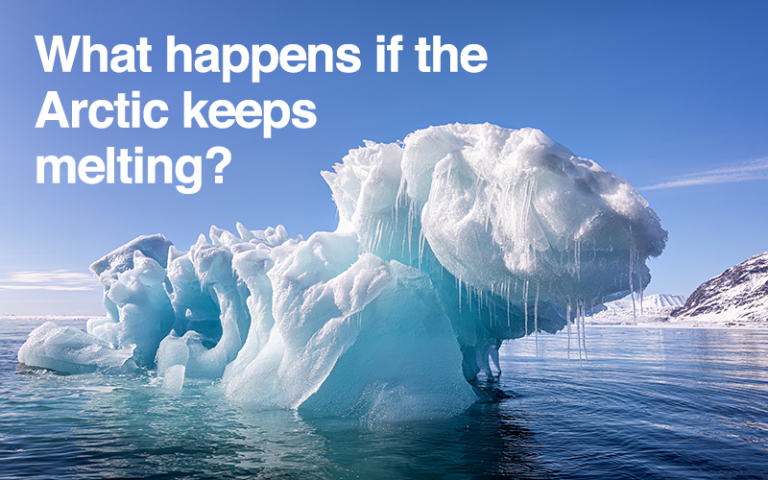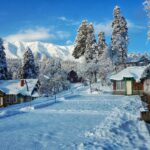When we think of the Arctic, we imagine a land of snow, ice, and polar bears. It feels far away, and many people believe what happens there doesn’t affect their daily lives. But that’s not true.
The Arctic is like the Earth’s air conditioner. It helps keep the planet cool and balanced. But right now, the Arctic is warming up faster than anywhere else in the world. The ice is melting — and this is changing weather patterns even in places thousands of kilometers away.
So, how does melting ice in the Arctic affect the rest of the world, including your weather?
Let’s break it down in very simple terms.
❄️ What’s Happening in the Arctic?
The Arctic is the area around the North Pole. It includes the Arctic Ocean, Greenland, and parts of countries like Canada, Russia, Norway, and the USA (Alaska).
Every summer, some of the sea ice melts naturally. But over the past few decades, too much ice is melting — and not enough is freezing back in winter.
Why? Because of global warming. The Earth is getting hotter due to pollution, especially from burning coal, oil, and gas. This releases gases like carbon dioxide, which trap heat in the atmosphere.
As a result:
- Arctic temperatures are rising.
- Sea ice is shrinking.
- Snow is melting earlier and faster.
- Glaciers are disappearing.
🌍 Why Should We Care About Arctic Ice?
You might wonder — “Why does it matter if some ice melts far away?”
Here’s why it’s a big deal:
- Ice reflects sunlight back into space, helping cool the planet.
- When ice melts, dark ocean water absorbs more heat, making Earth even warmer.
- Melting ice affects air and water flow around the world, which changes weather patterns.
Let’s understand how that works.
🌀 The Jet Stream Gets Weaker and Wavier
There’s something high up in the sky called the jet stream — a fast-moving band of wind that circles the Earth.
The jet stream helps control weather patterns. It pushes storms, rain, cold, and heat around the planet.
But here’s the problem:
- The Arctic is warming faster than the rest of the Earth.
- This reduces the temperature difference between the cold Arctic and warmer middle regions.
- A smaller temperature gap makes the jet stream weaker and slower.
- A weak jet stream becomes wavy, like a loose rope.
What happens when the jet stream gets wavy?
- Cold air from the Arctic can dip south, causing unusual snow or cold in places like Texas or India.
- Warm air from the south can move north, making Arctic areas even warmer.
- Storms can stall in one place, leading to floods or heatwaves.
This is why melting Arctic ice can lead to extreme weather events in faraway countries.
🌊 Ocean Currents Are Also Changing
The Arctic also affects the ocean currents — the movement of warm and cold water around the globe.
Melting ice from Greenland and the Arctic adds a lot of freshwater to the salty ocean. This changes the balance of the ocean and can slow down important currents like the Gulf Stream.
What is the Gulf Stream?
- It’s a strong ocean current that brings warm water from the tropics to Europe and North America.
- It helps keep places like the UK and parts of Europe mild in winter.
If this current slows down due to Arctic melting:
- Europe could get colder in winter.
- West Africa and South Asia could face changes in monsoons and rainfall.
- South America might experience more droughts.
🌧️ Changing Rainfall Patterns
Melting Arctic ice also affects where and how much it rains.
- Some places might get too much rain (floods).
- Others might get too little (droughts).
For example:
- India’s monsoon is affected by temperature and wind changes caused by Arctic warming.
- California may get longer dry spells or intense storms.
- Africa could see changes in food-growing seasons due to shifts in rainfall.
🌡️ More Heatwaves and Wild Weather
Without the Arctic ice to keep things cool, heatwaves are becoming more common around the world.
- In Europe, record-breaking temperatures are being reported.
- In Asia, people are suffering from extreme summer heat.
- In Australia and the US, wildfires are increasing.
All of these are connected to global changes triggered, in part, by Arctic ice loss.
🧊 Arctic Melting Means Rising Sea Levels Too
When glaciers and ice sheets in Greenland melt, the water flows into the ocean, raising sea levels.
This puts coastal cities at risk:
- Mumbai
- Kolkata
- New York
- Jakarta
- Dhaka
These cities may face more flooding, storms, and damage in the coming years.
💭 Final Thoughts – Why It Matters to You
Even if you live far from the Arctic, its ice plays a big role in your daily life:
- It helps keep the Earth cool.
- It controls weather patterns and ocean currents.
- It affects rains, heat, and storms around the globe.
As the Arctic warms and melts, weather becomes more unpredictable and dangerous for everyone — not just polar bears and penguins.
✅ What Can We Do?
We can’t stop all the melting right away, but we can slow it down by:
- Using less electricity and fuel.
- Driving less, walking more.
- Planting trees.
- Supporting clean energy like solar and wind.
- Spreading awareness about climate change.
Every small action counts.
So the next time you feel a heatwave, see a flood on the news, or notice strange weather — remember, the Arctic may be far, but it’s connected to you in more ways than you think.


